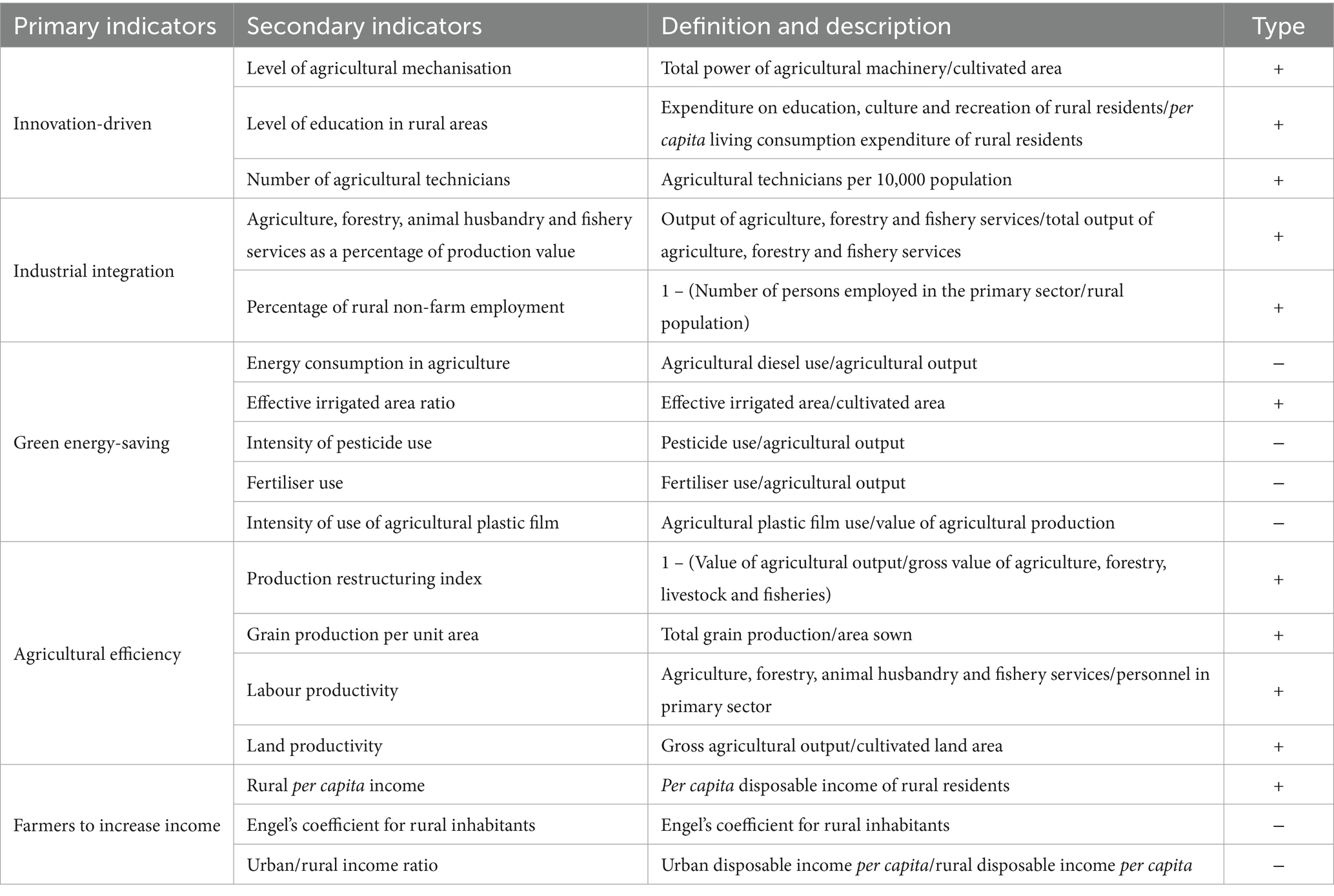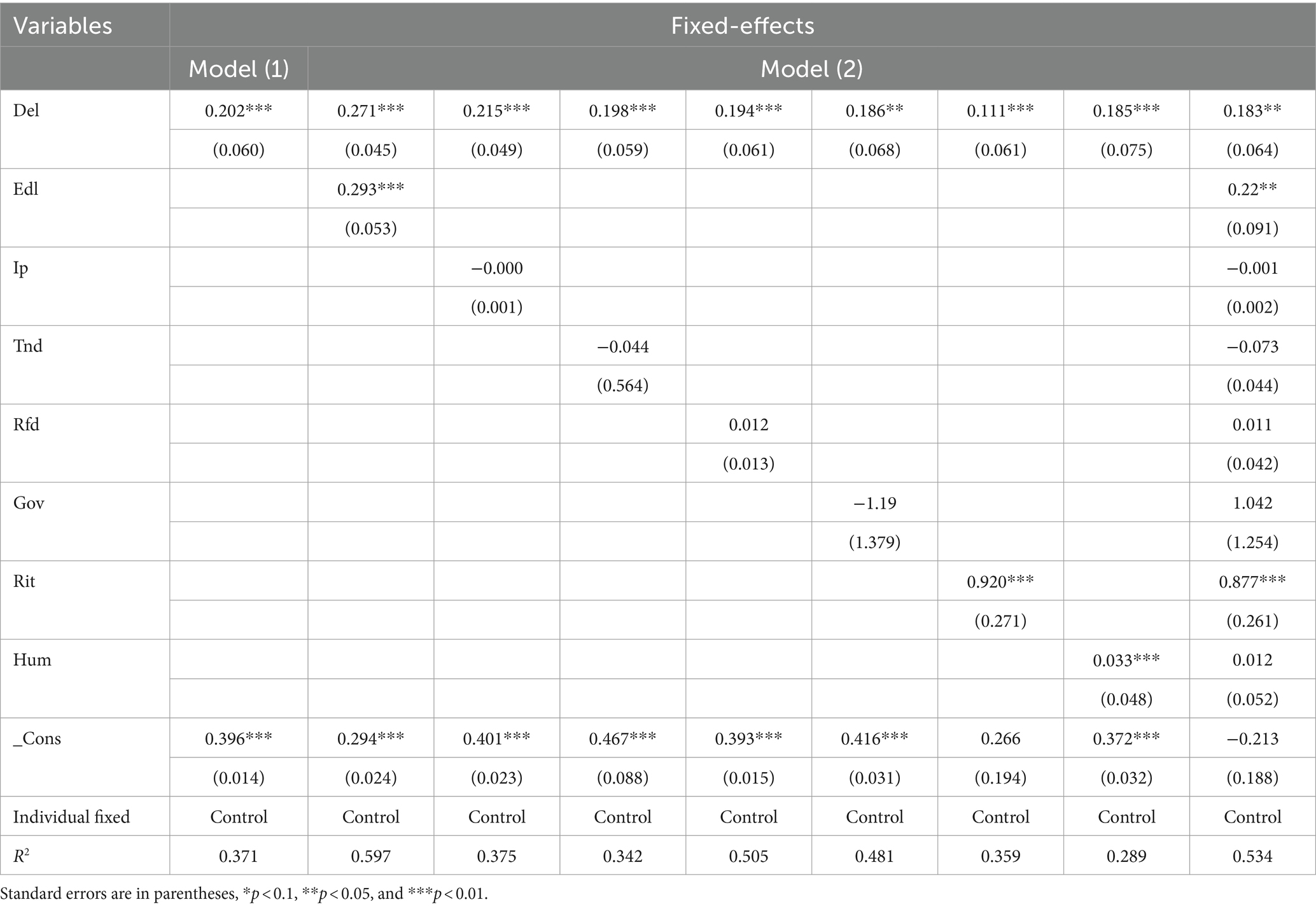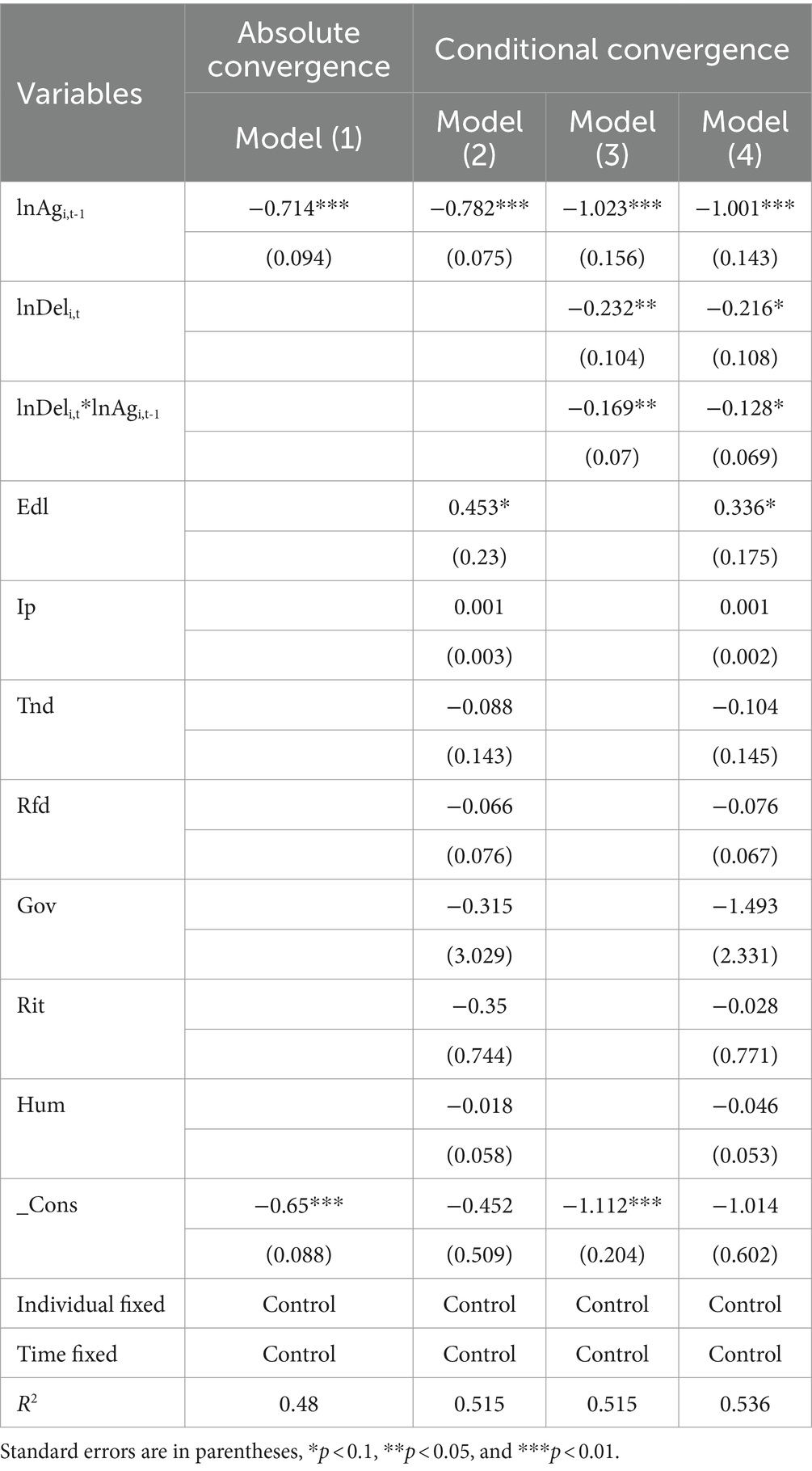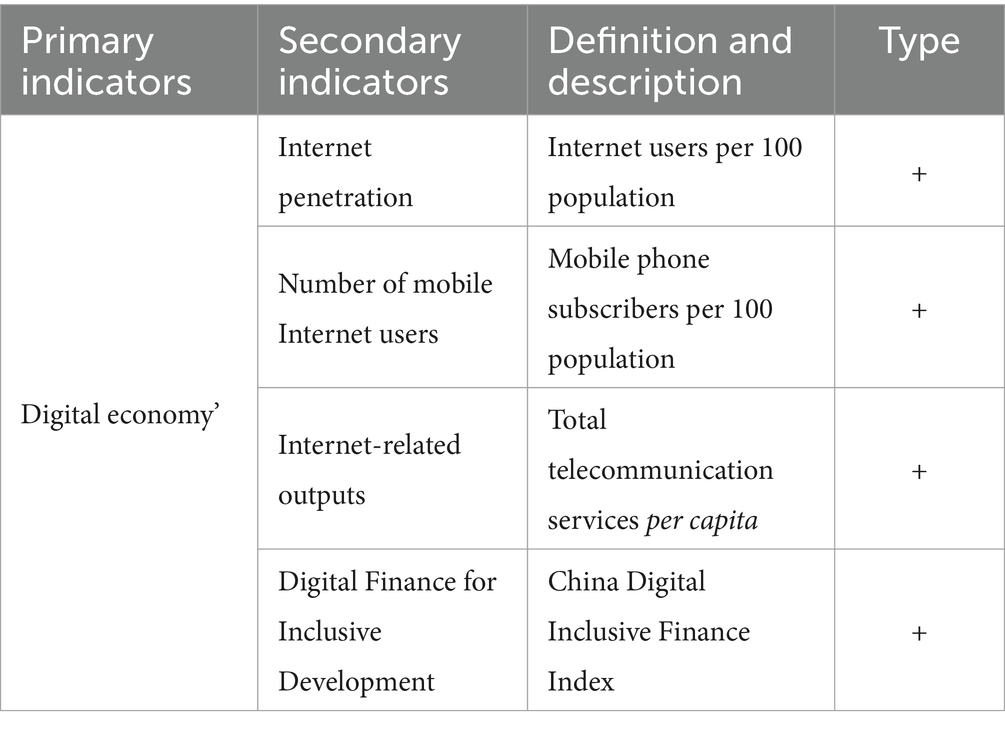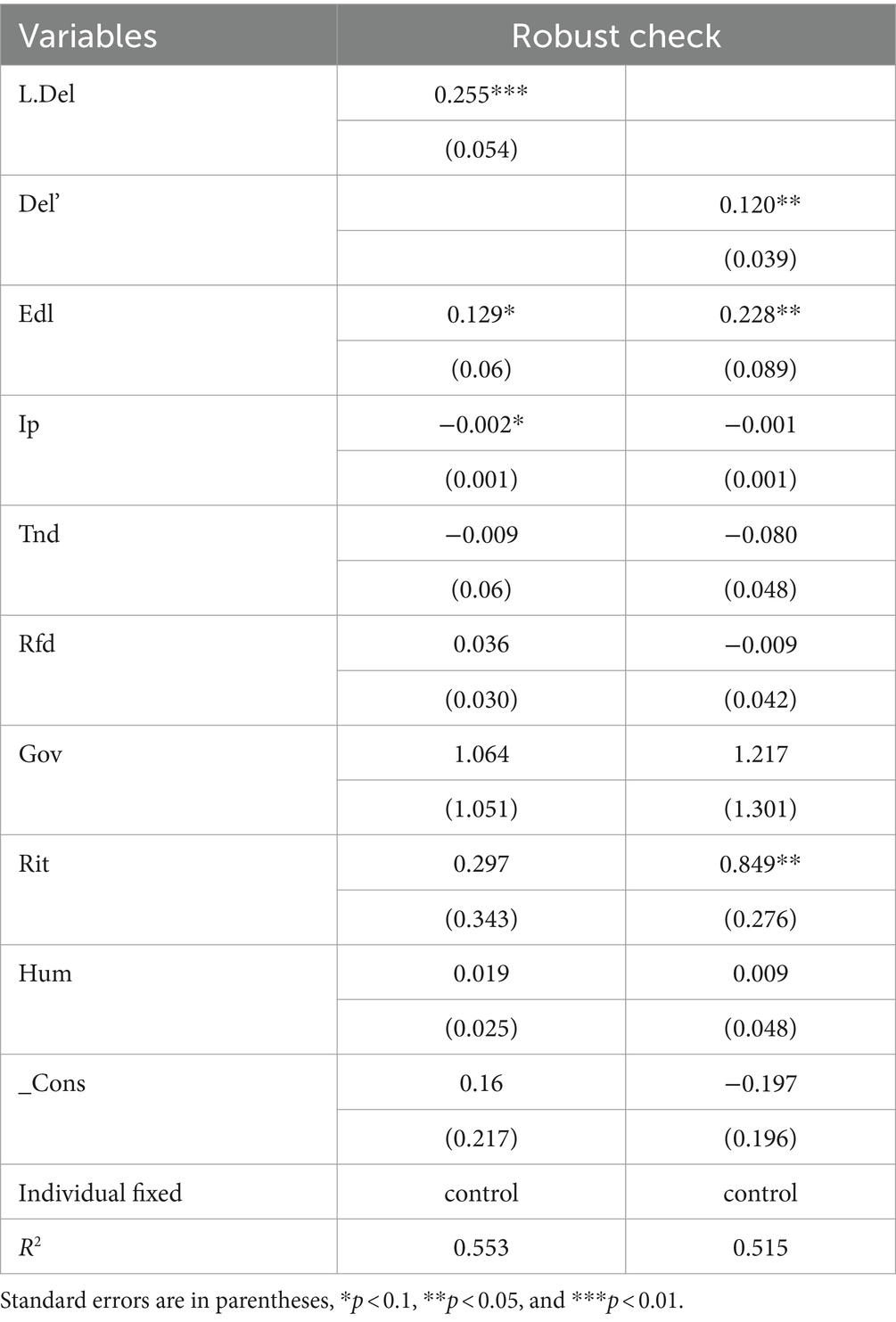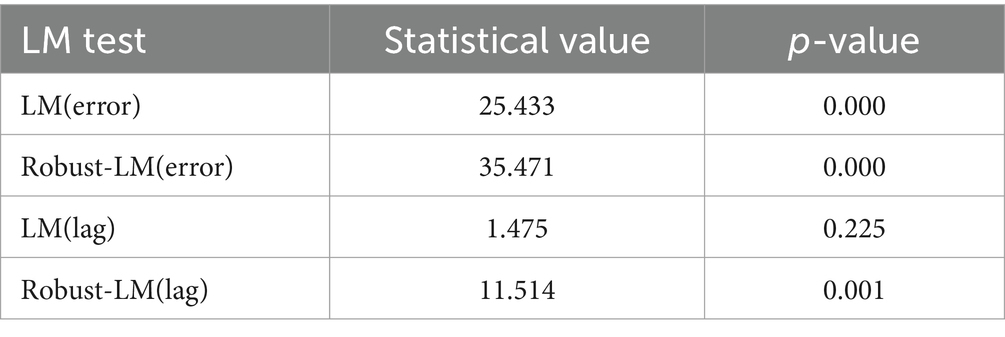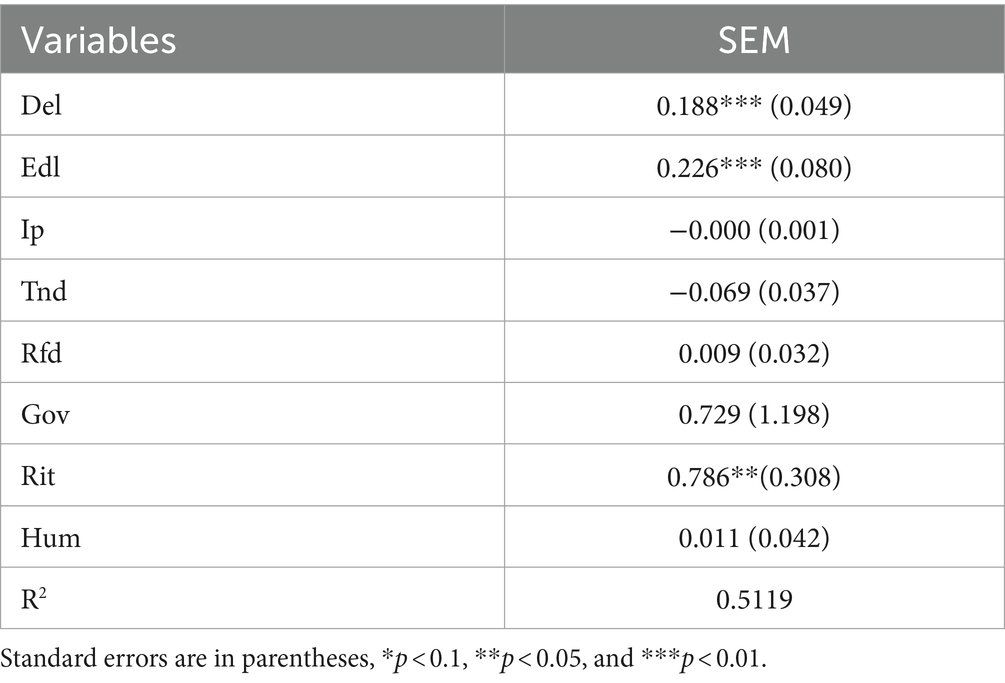- Business School, Yangzhou University, Yangzhou, China
Agricultural modernization can only be attained through the high-quality development of agriculture, which is made possible by the deep integration of the digital economy with traditional agriculture. From the perspective of the entire agricultural industry chain, this paper offers a theoretical and empirical examination of the digital economy’s role in enabling high-quality agricultural development. The fixed effects model, convergence test, threshold model, and spatial error model were implemented based on the panel data of 13 cities in Jiangsu Province from 2013 to 2021 to validate the role of the digital economy in enabling high-quality agricultural development. The findings indicated that first, for every 1% increased in the level of digital economy development, the level of high-quality agricultural development increased by approximately 0.183%. Second, the high-quality development of agriculture had the characteristics of absolute convergence and conditional convergence, and there was a non-linear character in the role of the digital economy in the high-quality agricultural development. Third, for every 1% increase in the development level of digital inclusive finance, the level of high-quality agricultural development in surrounding areas with similar economic levels will be improved by about 0.188%.In this regard, Jiangsu Province should grasp the opportunity of the era of digital economic development, continue to strengthen the construction of digital economic development in backward areas, and attach great importance to inter-regional exchanges and cooperation in the construction of digital agriculture.
1 Introduction
In the 20th Party Congress report, General Secretary Xi (2022a,b) noted that “the primary task of comprehensively building a socialist modernized country is high-quality development (Xi, 2022a,b).”China’s economic development has entered a new era, gradually shifting from speed-based growth to quality and efficiency-based development, in line with the development process of “quantitative change” to “qualitative change.” A fundamental sector of the economy that affects people’s lives and sustains the country is agriculture. A strong agricultural country is the foundation of a socialist modernized country, and achieving high-quality development is the primary task in promoting agricultural modernization. China began a new journey after the 14th Five-Year Plan to build an all-around socialist modernization country. While high-quality agricultural development faces rare new opportunities, it is still constrained by systemic, structural, and cyclical factors, necessitating the search for a new engine and the activation of new kinetic energy. There is a lot of potential for the development of digital agriculture and digital villages with the application of 5G technology, cloud computing, the Internet of Things, and other digital technologies in the field of agriculture; in fact, “digitalization + agriculture” has emerged as a new trend for future development.
In this regard, this paper understands digital economy as a series of economic and social activities that take data as the key production factor, platform economy and sharing economy as the main business model, digital infrastructure as the material and technological foundation, and digital financial inclusion as the main carrier in the future, and through the innovative breakthroughs in digital technology, strengthen the in-depth fusion with other industries, and continue to promote the upstream and downstream transformation and upgrading of the industrial chain. At the same time, high-quality agricultural development is defined as: taking agricultural science and technology innovation as the basis and driving force, expanding the multifunctionality of agriculture by adjusting the structure of the agricultural industry and promoting multi-industry integration, actively promoting the greening of agricultural production methods, extending the agricultural industry chain, enhancing the added-value of agricultural products, continuously improving agricultural efficiency, steadily increasing the incomes of farmers, guaranteeing the supply of sufficient agricultural products, and improving the development gap between urban and rural areas.
The digital economy, with its high levels of innovation, permeability, and wide reach, has contributed to the development of a comprehensive, high-end agricultural industry chain. This has raised the bar for intelligent, environmentally friendly, and service-oriented agricultural development and greatly increased the productivity of farmers’ income and agricultural output. Specifically, the digital economy transforms the traditional agricultural industry chain, mainly through the following five paths to directly drive the high-quality development of agriculture: Specifically, the transformation of the traditional agricultural industry chain through the digital economy mainly drives high-quality agricultural development through the following five paths: The first is the technological transformation of agricultural production; The second is to expand the multifunctionality of agriculture; The third is the application of agricultural Internet of Things; The fourth is the development of agricultural information service industry; The fifth is the rise of rural e-commerce.
Jiangsu Province is working to become “the first province of digital integration” because it is the only significant grain-producing province among the economically developed provinces in the south. As such, the study of its high-quality agricultural development and digital economy is the most representative, contributing to the advancement of this field of study and serving as a benchmark for other regions. Based on this, this paper measures the degree of the digital economy and high-quality agricultural development in Jiangsu Province and verifies the influence of the digital economy on high-quality agricultural development by combining the agricultural situation in Jiangsu Province with the requirements of the era of high-quality development. Therefore, it is necessary to use the fixed-effects model, convergence model, threshold model and spatial model to empirically test and theoretically analyse the intrinsic mechanism of the digital economy empowering the high-quality agricultural development in Jiangsu.
The next part of this paper is organised as follows: in the second part, the theoretical and empirical literature on digital economy-enabled high-quality agricultural development is sorted out, the shortcomings of the existing literature are uncovered, and the contribution of this paper is elaborated to provide guidance for the subsequent analyses. In the third part, the theoretical mechanism of the digital economy’s impact on the high-quality development of agriculture from the agricultural industry chain’s scientific and technological upgrading, the integration of the three industries, the ecological supervision, the vertical extension, the horizontal extension of the five aspects of the theoretical mechanism is explored, and the corresponding research hypotheses are put forward. In the fourth part, the model selection of digital economy empowering agricultural high-quality development is explained, and data sources and variable descriptions are introduced to lay the foundation for further research on the influence mechanism of the two. In the fifth part, through the fixed effect model, β convergence model, threshold effect model, spatial effect model on the role of the digital economy to influence the high-quality development of agriculture in Jiangsu Province to empirically test the mechanism, the quantitative information obtained to provide data support for policy implementation. In the sixth part, the main conclusions of the previous study are summarised, and the countermeasure suggestions for the digital economy to boost the high-quality development of agriculture in Jiangsu Province are put forward in the light of the reality of Jiangsu Province’s provincial and agricultural conditions and the requirements for high-quality development of agriculture in the new era.
2 Literature review
2.1 Theoretical underpinnings
Mellor (1967), an American economist, divided the process of transformation from traditional to modern agriculture into three stages, including the stage of technological stagnation, the stage of labour-intensive technological progress, and the stage of capital-intensive technological progress in the light of the actual situation of developing countries (Mellor, 1967). His three-stage theory of agricultural development demonstrates the significant role of technology in agricultural development and states that in the traditional agriculture stage, technology stagnates, at which point increased agricultural production depends on the extent of traditional factor inputs. In the transitional stage, capital-saving agricultural technologies or increased agricultural labour are used to improve agricultural productivity. Until the modern agricultural stage, the broader role of science and technology in agricultural development has been emphasised. China is in the transition phase of agricultural modernisation, and in order to achieve a high level of quality development, it is necessary to pay attention to the practical application of science and technology, including digital technology, in the field of agriculture.
Schumpeter et al. (1934) first introduced the concept of “innovation” in his Theory of Economic Development Schumpeter believed that “innovation is the introduction of new factors and conditions of production or the establishment of a new function in the production system, and through these activities to obtain potential benefits. “On this basis, many scholars have explored the relationship between technological innovation and market demand. The first view is that technological innovation drives market demand, Schumpeter (1942) believes that technological innovation is dominant, and it is the market efforts of innovative enterprises that make consumers change their demand preferences (Schumpeter, 1942). The second view is that market demand leads to technological innovation, Schmookler (1962) proposed that the patent invention activities are still in pursuit of market profits, and market profits are affected by the market demand, so the market demand will lead to the innovation behaviour of enterprises (Schmookler, 1962). The third point of view is that market demand interacts with technological innovation. Freeman (1987) suggest that the association of science, technology and market is complex, interactive and multi-directional (Freeman, 1987).
With the acceleration of global integration and technological progress, technological innovation has been broken down into multiple links, and different countries have taken over the corresponding links according to their technological advantages and carried out technological integration, ultimately forming a global technological innovation chain. In the industrial economic era, the diffusion of science and technology was mostly carried out indirectly by industrial relocation and supply of core components, and late-developing countries could learn and absorb advanced technologies by importing intermediate goods (Acharya and Keller, 2008; Fritsch and Görg, 2015), and could also improve their technological level through import substitution and increasing their own technological innovation, forming the “stem-secondary effect.” This has led to a “stem-secondary effect” (Arrow, 1971; Goldberg et al., 2010; Bloom et al., 2016). After entering the era of digital economy, knowledge and technology can be transferred directly through intellectual property rights, and with the help of the Internet and digital technology, knowledge can be spread instantly across national borders, and is no longer subject to the limitations of time and space, which accelerates the entry of advanced science and technology from the leading countries to the lagging countries. In the field of agriculture and rural areas, knowledge and innovation achievements accelerate the integration with agricultural production through the Internet and other information technologies, accelerate the transfer of advanced agricultural science and technology and management experience from abroad to the country, take into account the production needs of farmers and the needs of the consumer market, provide farmers with new technologies and information that can be cognitively accepted, and provide consumers with new products and services that are safe and secure, expand the rate of transformation of agricultural scientific and technological achievements, and increase agricultural production and economic benefits, empowering China’s high-quality agricultural development.
2.2 Empirical review
In the established literature, there are not many studies dedicated to exploring the digital economy to empower the high-quality agricultural development, but the studies related to it are relatively rich. For the relationship between digitalisation and high-quality agricultural development, how to grasp the opportunities for reform in the new era and explore new engines for agricultural high-quality development is the focus of scholars’ research. Digital technology can empower high-quality development of agriculture from three aspects: industry, production and operation. From the agricultural industry, the use of digital technology to achieve vertical unification and horizontal expansion of the industry focuses on solving the problem of rational allocation of agricultural resources and factors and the supply efficiency of agricultural products (Chernova et al., 2022); from the agricultural production aspect, the use of digital technology to change the mode of production and the means of production focuses on solving the problem of agricultural production efficiency and agricultural production power; from the agricultural management aspect, the use of digital technology innovation in agricultural quality development is the main focus of scholars’ research. From the perspective of agricultural production, the use of digital technology to change the mode of production and means of production focuses on solving the problems of agricultural production efficiency and agricultural production power; from the perspective of agricultural operation, the use of digital technology to innovate the main body of operation and service mode focuses on solving the problems of operational efficiency and organisational system (Luo et al., 2022). The digital economy can reduce the transaction cost of enterprise information collection by building a digital platform, optimise the business environment to promote the convergence and integration of multiple innovation subjects, build a highland for gathering digital technology talents, and promote R&D cooperation and technology exchange among enterprises to help bring into play the effect of innovation network and reshape the business model (Cardona et al., 2013). The construction of digital villages can fully absorb the dividends brought by digital technology, which can help explore the potential of agricultural development, promote agricultural scientific and technological innovation, and expand the agricultural factor market (Xia et al., 2019). In addition, a new type of finance combined with digital technology can also play a great role in promoting agricultural development. Digital finance promotes the green development of agriculture by improving the level of education, promoting the construction of digital infrastructure, and stimulating the innovation of traditional finance (Guo et al., 2022); and promotes the integrated development of rural industry by promoting technological innovation, improving the level of agricultural modernisation, and constructing a risk-sharing mechanism (Ge et al., 2022).
The majority of empirical research to date indicates that the digital economy significantly facilitates the high-quality agriculture development (Li and Yue, 2022; Zhou and Li, 2022). It should be noted that there might be a non-linear relationship between the digital economy and the high-quality agricultural development (Lu and Du, 2022; Li and He, 2023). Meanwhile, due to the digital economy’s ability to transcend geographical boundaries, researchers have previously examined spatial impact using the neighboring spatial weight matrix or the geographic inverse distance spatial weight matrix (Wang et al., 2023; Yi et al., 2023). These analyses have confirmed that there is a spatial spillover effect and that the digital economy plays a significant role in fostering high-quality agriculture development in the surrounding areas. The literature review mentioned above demonstrates that: (1) Existing studies mostly focus on a single or several industrial segments, ignoring the need for a comprehensive examination from the dimension of the entire agricultural industry chain. (2) The connotation of agricultural high-quality development is not yet clearly defined and measured, and the indicators are more diverse in terms of measurement dimensions and methods. (3) In the existing empirical analyses on the impact of the digital economy on the high-quality development of agriculture, the conclusions obtained from different empirical studies are not consistent due to the differences in theoretical mechanisms, measurement methods and model selection.
2.3 Contribution
This paper’s primary marginal contributions are as follows: (1) it explains how the digital economy supports high-quality agriculture from five perspectives within the agricultural industry chain: scientific and technological innovation, industrial integration, ecological supervision, vertical and horizontal extension, and integration of the three industries. (2) It delves deeply into the workings of the digital economy’s mechanism supporting high-quality agriculture development; using the entropy power method, it creates comprehensive evaluation indicators of high-quality agriculture development in the five dimensions of “scientific and technological innovation, industrial integration, green environmental protection, agricultural efficiency, and farmers’ income, “thereby enhancing the understanding of the field. (3) To establish a foundation for a thorough evaluation of the influence of the digital economy on the high-quality development of agriculture, it is necessary to test the enabling role of the digital economy in the high-quality development of agriculture from four perspectives: fixed, convergence, threshold, and spatial effects. (4) It is necessary to conduct additional research on the spatial spillover effect of the digital economy on the high-quality agriculture development in regions with similar economic levels because the development of the digital economy in these areas is likely to contribute to the local high-quality agriculture development.
3 Mechanisms of action and research hypotheses
3.1 Mechanisms of action
Xi Jinping, the General Secretary of the Communist Party of China, pointed out that “it is necessary to grasp the direction of digitalization, networking, and intelligence, promote the digitalization of manufacturing, service, agriculture and other industries, use the new technology of the Internet to carry out an all-round, whole-chain transformation of traditional industries, improve total factor productivity, and give full play to the amplifying, superimposing, and multiplying effects of digital technology on economic development” (Xi, 2022a,b). As he said, achieving high-quality agricultural development requires the integration of the digital economy into traditional agriculture. This represents China’s agricultural modernization with tremendous development potential (Li and He, 2023). Specifically, the digital economy transforms the entire industry chain of traditional agriculture, mainly by directly driving high-quality agricultural development through the following five paths (Figure 1).
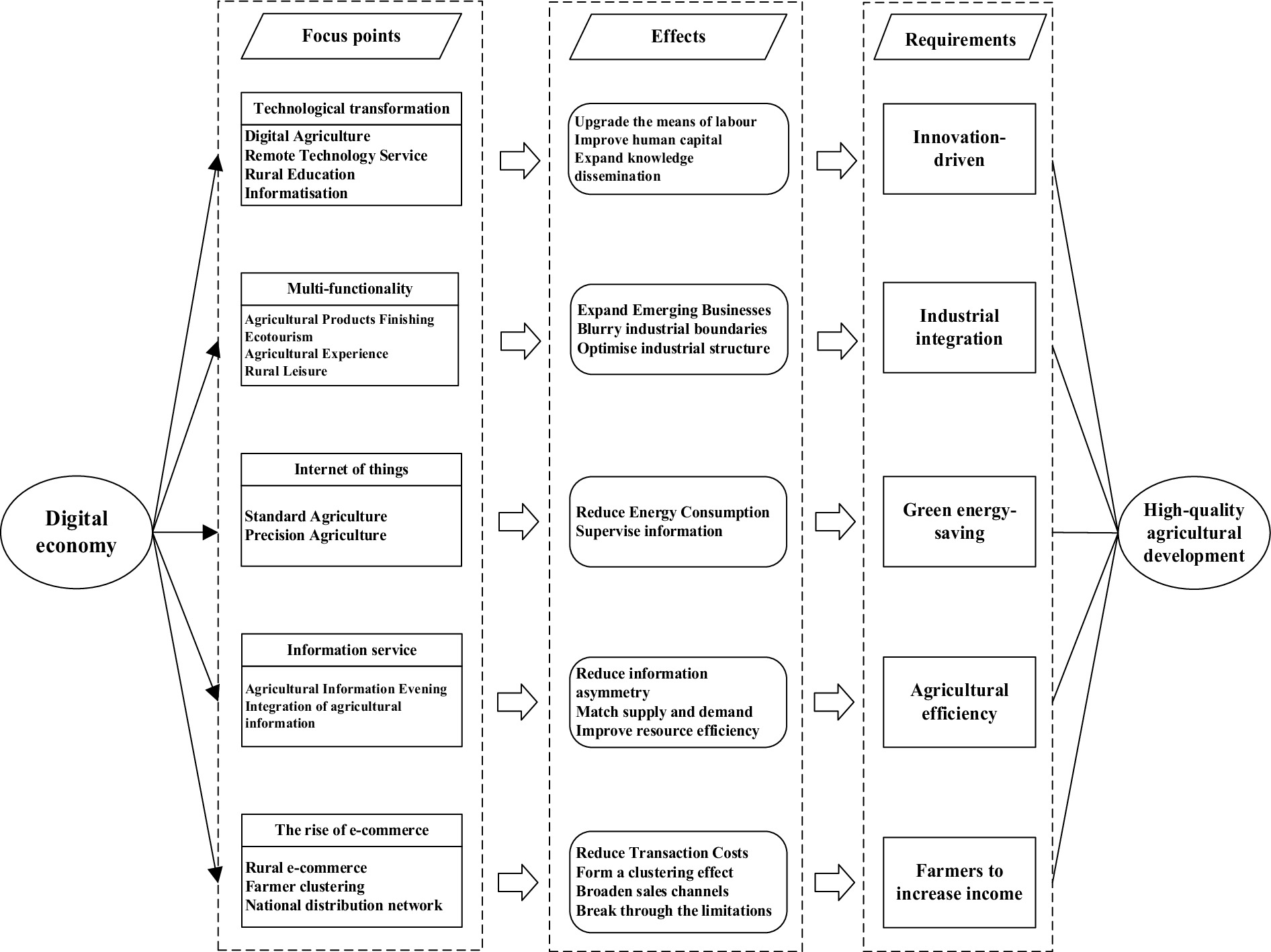
Figure 1. Mechanisms inherent in the digital economy enabling high-quality agricultural development.
First, we can improve the entire science and technology innovation chain of the agricultural industry and propel the growth of agricultural innovation by technologically revolutionizing agricultural output. According to the new economic growth theory, the advancement of knowledge and technology plays a significant role in achieving long-term economic growth. The growth of the digital economy can also encourage the accumulation of knowledge throughout society and, to some extent, alter people’s production and way of life (Zhang and Chen, 2021). Traditional agricultural production is being altered by artificial intelligence, the Internet, and other digital technologies. Big data and cloud computing applications in agriculture are also driving the evolution of the industry toward intelligence and digitalization. Through the following three main channels, the transformation of traditional agriculture into modern agriculture is made possible by the deep integration of the digital economy with the agricultural industry-wide science and technology innovation chain: Firstly, it is achieved by strengthening the use of agricultural machinery, upgrading the quality of agricultural labor, and reducing the consumption of rural human capital. Secondly, the main body of agricultural labor is expanded through the spillover effect of information and knowledge, raising farmers’ educational levels and improving the quality of rural human resources. Thirdly, the digital technology diffusion impact increases the capabilities of rural human resources, speeds up the training of agricultural technicians, and encourages the adoption of agricultural technology. It helps to expand the mechanized scale of agricultural production and cultivate agricultural scientific and technological talents who know technology and management through the innovation effect of digital science and technology, the diffusion effect of digital technology, and the spillover effect of information knowledge. This helps to better realize large-scale agricultural production and information management, and to complete the transformation of agricultural production technology from empirical to scientific modernization.
Second, it maximizes the synergistic chain of the entire agricultural industry structure and fosters integrated development of the three industries through the expansion of agricultural multifunctionality. According to the theory of industrial integration, deregulation and technological advancements have led to industrial integration. Industries then need to integrate their markets, products, and technologies to complete the process and, ultimately, alter the cooperative and competitive dynamics between industrial enterprises (Hu and Xing, 2003; Su et al., 2016). The most compelling reason for industrial integration in the age of the digital economy is the invention of new digital technologies. The permeability of these technologies can facilitate the interrelationship of the information sector with traditional services, industry, and agriculture. Artificial intelligence and the Internet of Things represent a new generation of digital technologies characterized by diversity, high permeability, and natural integration with rural industries. These technologies are the main forces behind the scientific and technological revolution as well as industrial innovation. On the one hand, a new trend in the integration of rural industries is emerging in the form of agricultural cultivation, deep processing of agricultural products, eco-tourism, agricultural experiences, and the leisure countryside. The development of digital technology in rural industry has expanded the multifunctionality of agriculture. The deep integration of agriculture with advanced manufacturing and modern service industries can drive the adjustment of the internal industrial structure of agriculture and increase the proportion of high-yield new formats. On the other hand, the borders separating the upstream, midstream, and downstream segments of the agricultural business chain will become less distinct as digital technology advances, changing the structure of the agricultural industry chain as a whole. The supply capacity of rural areas would eventually enable the emergence of new forms of rural specialization in occupations, breaking through the initial production boundary of the primary industry and forming an integrated development mode between agriculture and secondary and tertiary industries (Li and Ruan, 2023a,b).
Third, it steers the environmentally friendly development of agriculture by managing the entire agricultural production process using the agricultural Internet of Things (IoT). According to the notion of sustainable development, future generations’ inventiveness in the multifaceted areas of technical advancement, management and production, and lifestyle mode will be crucial in finding a solution to resource and environmental crises (Fang et al., 2017). A new wave of scientific and technical revolution is being sparked by digital technology, and by applying it to agriculture, we can successfully address global issues related to resource utilization and environmental protection. Through the use of information technology, the digital economy is able to effectively guide and oversee the growth of agriculture’s green practices as well as encourage standardization and precision farming practices. For one thing, digital agriculture uses the low marginal cost of digital elements, intangible services, and sharing characteristics, which are characterized by low consumption and cleanliness, to effectively reduce energy consumption and improve the level of cleanliness. This is in contrast with the high energy consumption of traditional agriculture, manufacturing, and service industries (Wang et al., 2023). For another, digital agriculture achieves visualization and transparency of the entire agricultural production process by monitoring and managing the entire crop planting, irrigation, fertilization, pest control, and other production processes with the aid of digital cloud platforms and remote monitoring technologies, which realizes real-time feedback on crop growth.
Fourth, it facilitates vertical extension of the entire agricultural industry chain and enhances agricultural efficiency and quality through the growth of the agricultural information services sector. According to the demand-led paradigm (Mitchell and Schmookler, 1968), market demand directs technological innovation efforts and industrial progress. All agricultural production, whether focused on improving quality or quantity security, ultimately aims to meet market demand. The agricultural informatization service process can assist the agricultural production main body in organizing production to meet market demand, ensuring an efficient supply of agricultural products, and realizing the value of agricultural products to add value. With the addition of standardized agricultural information services in the planting (breeding), processing, and circulation linkages, the vertical extension of the entire agricultural industry chain primarily contributes to the growth of the information service sector (Gao et al., 2017). Production operators receive quick access to traceable and integrated agricultural product information via standardized agricultural information services, while end users receive the same information. Firstly, the proliferation of mobile devices and the advancement of digital technology have made it feasible to quickly realize agricultural information. The use of big data to assess the state of the agricultural product market, integrate local resource endowments, forecast market demand trends scientifically, pinpoint the agricultural industry that needs to be developed, successfully finish the supply and demand docking process, and resolve the issue of “what to produce.” Besides, applying digital technology to quickly obtain, process, and analyze agricultural information, concentrating efforts to break the bottleneck of industrial development, establishing a scientific production model that guides demand and accurately connects supply and demand, and solving the problem of “how to produce.” It encourages cost reduction and efficiency in agricultural production and enhances the effectiveness of rural resource allocation by offering full-dimensional and high-precision decision-making recommendations for the entire agricultural industry chain. Secondly, the integration of agricultural information is strongly supported by the creation of big data centers. The agricultural industry chain’s big data center can facilitate the production and supply of goods to meet the market demand. It can also rely on a variety of beneficial industrial systems with high levels of science and technology, robust processing power, and a comprehensive support system to carry out standardized production and realize the industrial symbiosis of “production records, information can be queried, flow can be tracked, quality can be traced, products can be recalled, and responsibility can be held accountable” through data linkage and sharing (Xia et al., 2019).
Fifth, it realizes farmers’ wealth and income, and encourages the horizontal expansion of the entire agricultural industry chain through the growth of rural e-commerce. The network platform economy can significantly lower the cost of sales based on “Metcalfe’s law” and “long-tail theory” (Stirling, 2003; Brynjolfsson et al., 2006). The digital economy can lower transaction costs, alter agricultural operations management, encourage changes in industrial forms and urban–rural economic patterns, and foster high-quality agricultural development because of its effective data, information sharing, and permeability. The integration of the growth of rural e-commerce with agricultural product processing firms is the primary factor driving the horizontal expansion of the entire agricultural industry chain (Gao et al., 2017). The digital economy’s integrated and inventive development has given rise to an e-commerce service platform that primarily improves agricultural products’ competitiveness through two means: farmer aggregation and the expansion of sales channels. Firstly, the digital economy promotes the agglomeration of farmers within the entire agricultural industry chain, forming large-scale production and specialized agglomeration within the chain, enhancing the discourse power of small farmers, and ensuring their benefits. The rise of e-commerce sites such as Taobao and Jingdong has given rural farmers access to low-cost, low-threshold platforms and opportunities, which have altered their place in the traditional industry chain in terms of income distribution (Wei and Wang, 2018). More importantly, “Taobao Village has successfully expanded the national sales network, which has improved small farmers’ bargaining power and negotiating position, while also increasing overall farmer income. This is because changing the original harvest does not worsen the income dilemma for farmers. Secondly, the digital economy has the potential to enhance the efficiency of agricultural product sales channels, expedite labor division and collaboration between urban and rural industries, foster closer exchanges among the various links in the industrial chain, and ultimately optimize the network system of urban and rural industrial chains (Zhou and Li, 2022). Agribusiness and cold-chain logistics recognize that agricultural products go straight from the field to the public table, which lowers intermediary losses and transaction costs and supports the coordinated development of urban–rural dualism. Additionally, the sales model of Internet live broadcasting with goods can put agricultural products into direct contact with consumers.
3.2 Research hypothesis
Summarizing the above mechanism analysis, the digital economy primarily enhances the entire agricultural industry chain and supports the growth of high-quality agriculture at the following five levels: Firstly, the technological transformation in agricultural production, which involves improving labor and human capital, spreading knowledge more widely, and propelling the innovative growth of agriculture by establishing digital agriculture, offering remote agrotechnical services, and providing educational materials. Secondly, agricultural multi-functionality, such as agricultural product finishing, eco-tourism, agricultural experience, and leisure countryside, and integrated development of tertiary industries, is achieved by blurring industrial boundaries and optimizing the industrial structure. Thirdly, the Internet of Agricultural Things (IoA), which effectively lowers energy consumption and chemical inputs through the information supervision of the entire agricultural production process and advances precision and standard agriculture to spearhead the development of agriculture in a greener manner. Fourthly, the growth of agricultural information services, which reduce information asymmetry, facilitate accurate supply and demand matching, enhance resource allocation efficiency, and help farmers realize the quality and efficiency of agriculture; Fifthly, the rise of rural e-commerce, which overcomes initial geographical and temporal barriers to assist farmers in clustering operations and building a nationwide sales network. This method lowers transaction costs, expands sales channels, and realizes farmers’ income generation and shared wealth. Thus, this paper proposes research hypothesis 1.
Hypothesis 1. The digital economy can contribute to high-quality agricultural development.
Some regions rely on capital, transportation, and industrial advantages, owing to differences in geographic location, climatic conditions, and resource endowment. Consequently, some regions experience a relative lag in agricultural development, and there is an uneven distribution of agricultural development across regions. Despite the rapid advancement of science and technology, the Internet of Things, big data, and other contemporary information technologies are being actively used in the field of agriculture in underdeveloped regions. In less developed regions, the application and popularization of various new technologies have decreased resource waste and increased agricultural production efficiency. Agricultural products with advantages in different regions can now more easily enter the market, and trade and circulation of agricultural products in underdeveloped regions are made easier by the globalization process’s advancement, increased information exchange between regions, and opening of the global market. Furthermore, following China’s all-encompassing triumph in the fight against poverty, the state has persisted in bolstering policy assistance for impoverished regions, expediting the development of infrastructure in underdeveloped areas, and promoting modernization of the agricultural sector in impoverished regions (Yi et al., 2023). As a result, lagging regions are expected to have higher rates of high-quality agricultural development than developed regions, which will eventually cause the differences in the levels of high-quality agricultural development between regions to gradually close.
There is a complex relationship between the digital economy and high-quality agricultural development, and the academic community has not yet come to a consensus on this relationship. On the one hand, the “digital dividend” brought about by the digital economy can help developed regions increase the efficiency with which labor, capital, and technology are allocated in the agricultural sector. Simultaneously, it can improve information sharing and exchange between developed and developing regions, effectively address the issue of information asymmetry, lower the learning costs of developing regions, and encourage modernization of the agricultural industrial structure. Additionally, it can effectively address the issue of information asymmetry, lower the learning costs of lagging regions, encourage the modernization of the agricultural industry structure, close the gap between regions’ high-quality agricultural development and coordinated development, and more. On the other hand, the digital economy may also lead to issues like the “digital divide” and “digital chimney” as a result of the aging population in rural areas of developing countries and the shortcomings of the digital technology infrastructure (Wang, 2023). These issues will worsen the “siphon effect” of the digital economy, which accelerates the flow and concentration of resources (material, human, and other) in the field of agriculture to developed countries, widening the gaps in high-quality agricultural development between regions. Hence, which of the two effects of “digital dividend” and “digital divide” is more significant in the development of the digital economy, that is, whether the digital economy can narrow the gap in regional agricultural development and successfully promote the convergence of high-quality regional agricultural development, is a key issue in implementing the strategy of agricultural modernization. Thus, this paper proposes research hypotheses 2 and 3.
Hypothesis 2. There is a convergence effect on the high-quality agricultural development.
Hypothesis 3. There is a non-linear character in the role of the digital economy in the high-quality agricultural development.
The deep penetration of the digital economy, high level of innovation, and broad reach have the potential to reduce the relationship between economic activity and place, foster cross-regional economic cooperation and division of labor, and produce spatial spillover effects. As a result, the degree of development of the digital economy in one location may have an impact on the level of high-quality agricultural development in another. For one thing, developed regions can benefit from the digital economy is by fully utilizing the technological spillover and demonstration effects (Zheng and Wan, 2023). This involves transferring advanced agricultural digital technology and management skills to neighboring, less developed regions. These advanced technologies and concepts can easily become the first to be popularized and disseminated in regions with similar levels of economic development, thereby closing the gap in agricultural development between regions. For another, Small towns have more development opportunities because of the spatial network effect of the digital economy, which can alter the traditional urban spatial pattern (Zhao and Wan, 2023). Agricultural practices in small towns with similar levels of economic development are more likely to replicate these new market exploration and sales opportunities because agricultural products can be sold more conveniently to a wider market using e-tailing and e-commerce platforms. In the context of the digital economy, small-town agriculture in areas with comparable levels of economic development can more easily adopt these new strategies for channel and market expansion and combine the unique aspects of their own agricultural development to reach the same level of development as large cities. Therefore, in areas with comparable levels of economic growth, the spatial spillover effects of the digital economy may act as a catalyst to raise the standard of high-quality agricultural development. Based on this, this paper proposes research hypothesis 4.
Hypothesis 4. The role of the digital economy in high-quality agricultural development has spatial spillover effects.
4 Model selection, data sources and description of variables
4.1 Model selection
The fixed effects model is suitable for analyzing panel data, which controls for time independent variables that are fixed across all cross sections and treatment groups. This model can control individual differences and better study the impact of time series changes. Owing to the robust Hausman test p-value of 0.004, this paper used a fixed-effects model to study the impact of the digital economy on the high-quality agricultural development. The model was set as follows:
The explanatory variable in Equation 1 represents the level of high-quality development of agriculture, the core explanatory variable represents the level of development of the digital economy, and represents a series of control variables, i stands for city, t stands for time, is a fixed effect, and is a random disturbance term.
This paper introduces a convergence model to further test the convergence of high-quality agricultural development. The convergence test has two forms, absolute and conditional. Absolute convergence indicates that, under consistent external conditions, the high-quality agricultural development in each city approaches the same level. Conditional convergence suggests that several other factors influence each city’s degree of high-quality agricultural growth. Referring to Barro and Sala-i-Martin (1997), this paper sets the absolute convergence model as follows:
In Equations 2, 3, is a constant, i stands for city, t stands for time, T is the length of the observation period, and are the output indicators of high-quality agricultural development at the end and beginning of the observation period, respectively, indicating the speed of convergence towards steady state, and are individual and time fixed effects, is a random disturbance term. This article takes T as 1, If <0 in Equation 2, this indicates that there is absolute convergence in high-quality agricultural development, and the smaller it is, the faster the speed of convergence. Further, this paper introduces the interaction term of the lag term of digital economy and high-quality agricultural development into the convergence model, which is used to measure the effect of digital economy on the convergence of the high-quality agricultural development, and the model is set as follows:
If <0 and ≠0 in Equation 3, it indicates that there is conditional convergence and that the digital economy has a certain impact on the convergence of high-quality agricultural development. In order to further reflect the reasons for the differences in the impact of the digital economy on the high-quality agricultural development in different regions, this paper further establishes a panel threshold model reflecting the relationship between the digital economy and the high-quality development of agriculture:
Where the meaning of , and in Equations 4 and 5 is consistent with Equation 1, is the threshold variable, in which the threshold variable can be taken as the index of high-quality agricultural development and the level of economic development of the region, are the threshold variables, , and are the coefficients to be estimated.
According to the different sources of spatial correlation effects, spatial econometric models can be divided into spatial lag models, spatial error models, and spatial Durbin models. The spatial lag model assumes that spatial correlation effects mainly come from the dependent variable, while the spatial error model assumes that spatial correlation effects are caused by the spatial correlation of the error term. Based on the subsequent test results, this paper chooses the spatial error model:
In Equations 6, 7, represents the spatial lag term of the error term, represents the spatial error correlation coefficient. The larger the , the stronger the spatial correlation caused by the error term.
4.2 Data sources
The data sources used in this paper are all from “Jiangsu Statistical Yearbook” and “Jiangsu Rural Statistical Yearbook,” in which some of the missing values in 2021 are filled in by linear interpolation. To exclude the influence of price, this paper takes 2013 as the base year, divides the base index of consumer price by the base index of the base year, and then multiplies it by the values of GDP, GDP per capita, science and technology expenditure, and total telecommunication business per capita of each region; the base index of consumer price of rural areas is divided by the base index of the base year, and then multiplied by the values of total agricultural output value, total agriculture, forestry, animal husbandry, and fishery output value, and total per capita disposable income of the rural areas, and finally obtains the real value. The real value is obtained by multiplying the values of gross agricultural output, gross agricultural output, forestry, animal husbandry and fishery output, and rural per capita disposable income.
4.3 Description of variables
1. Explained variable: high-quality agricultural development (Ag). How to measure the level of high-quality development of agriculture is still inconclusive in the academic community, this paper refers to the index system identified in the study of Wang et al. (2023), and based on the actual situation of agriculture in Jiangsu Province, respectively, from the innovation-driven, industrial integration, green energy-saving, agricultural efficiency, and farmers to increase income in five dimensions to select a total of 17 indicators to measure the level of high-quality agricultural development (Table 1), the entropy method to calculate the index of the level of high-quality development of agriculture in 13 cities (states) in Jiangsu Province from 2013 to 2021 (Wang et al., 2023). The index of the high-quality agricultural development level of 13 cities (states) in Jiangsu Province in 2013–2021 was calculated using the entropy value method.
2. Core explanatory variable: digital economy (Del). Referring to the research of Zhao et al. (2020), this study selected five indicators to measure the level of regional digital economy development from the dimensions of digital infrastructure and digital inclusive finance development (Table 2). In terms of digital infrastructure, this paper selects the number of Internet users per 100 people, the number of cell phone users per 100 people, the total number of telecommunication services per capita, and the expenditure on science and technology as measurement indicators. As for the development level of digital inclusive finance, this study uses the Peking University Digital Inclusive Finance Index to measure the development level of regional digital inclusive finance, which can reflect the development level of digital inclusive finance in a more objective way by considering three dimensions: the depth of the use of digital inclusive finance, the breadth of coverage, and the degree of digital support services. The above index is calculated by the entropy value method to determine the index of the digital economy development level of 13 cities (states) in Jiangsu Province from 2013 to 2021.
3. Control variables. To make the model more robust, this paper draws on the research results of previous scholars (Zhang and Li, 2020; Li and Yue, 2022; Fu and Li, 2023; Li and He, 2023; Yi et al., 2023; Li and Ruan, 2023a,b), and on the core explanatory variables, the following control variables were selected: (a) Opening degree (Ope): measured by the ratio of the total amount of imports and exports to GDP. (b) Industrialization process (Ind): measured by the ratio of value-added of secondary and tertiary industries to the value-added of primary industry. (c) Transportation network density (Tra): characterized by the ratio of road mileage to regional area. (d) Rural financial development (Rfd): measured by the ratio of the total amount of rural agriculture-related loans to the total output value of agriculture, forestry, animal husbandry and fishery. (e) Government support (Gov): measured by the ratio of expenditures on agriculture, forestry and water to GDP. (f) Rural labor transfer (Rlt): measured by the ratio of the difference between the number of people employed in rural areas and the number of people employed in agriculture, forestry, animal husbandry and fisheries to the number of people employed in rural areas. (g) Human capital (Hum): measured by the number of full-time teachers in higher education per 10,000 people (See Table 3).
5 Analysis of empirical results
5.1 Spatial and temporal characterization of high-quality agricultural development
In this paper, the kernel density curves of 13 cities in Jiangsu Province in odd-numbered years from 2013 to 2021 were plotted using STATA17 software (Figure 2) to analyze the spatial and temporal characteristics of high-quality agricultural development. As shown in Figure 2, the distribution dynamics of high-quality agricultural development have the following characteristics. From the perspective of the time dimension, the center of the distribution curve of high-quality agricultural development as well as the change interval during the sample observation period are gradually shifted to the right, which indicates that the overall level of high-quality agricultural development in the 13 cities of Jiangsu Province is on the rise, and the modernization of agriculture is highly effective. The peak of the distribution curve of kernel density presents a gradual upward trend. The peak of the kernel density distribution curve shows a gradual upward trend, which indicates to a certain extent that the level of high-quality agricultural development in the 13 cities in Jiangsu Province gradually “converges “during the sample observation period. From the spatial dimension, the distribution of the level of high-quality agricultural development in China has the phenomenon of “right trailing” but has a tendency to converge, which indicates that there are still differences in the level of high-quality agricultural development among the 13 cities in Jiangsu Province, although the gap between cities with high levels of high-quality agricultural development and those with low levels of high-quality agricultural development has been narrowed (Yi et al., 2023).
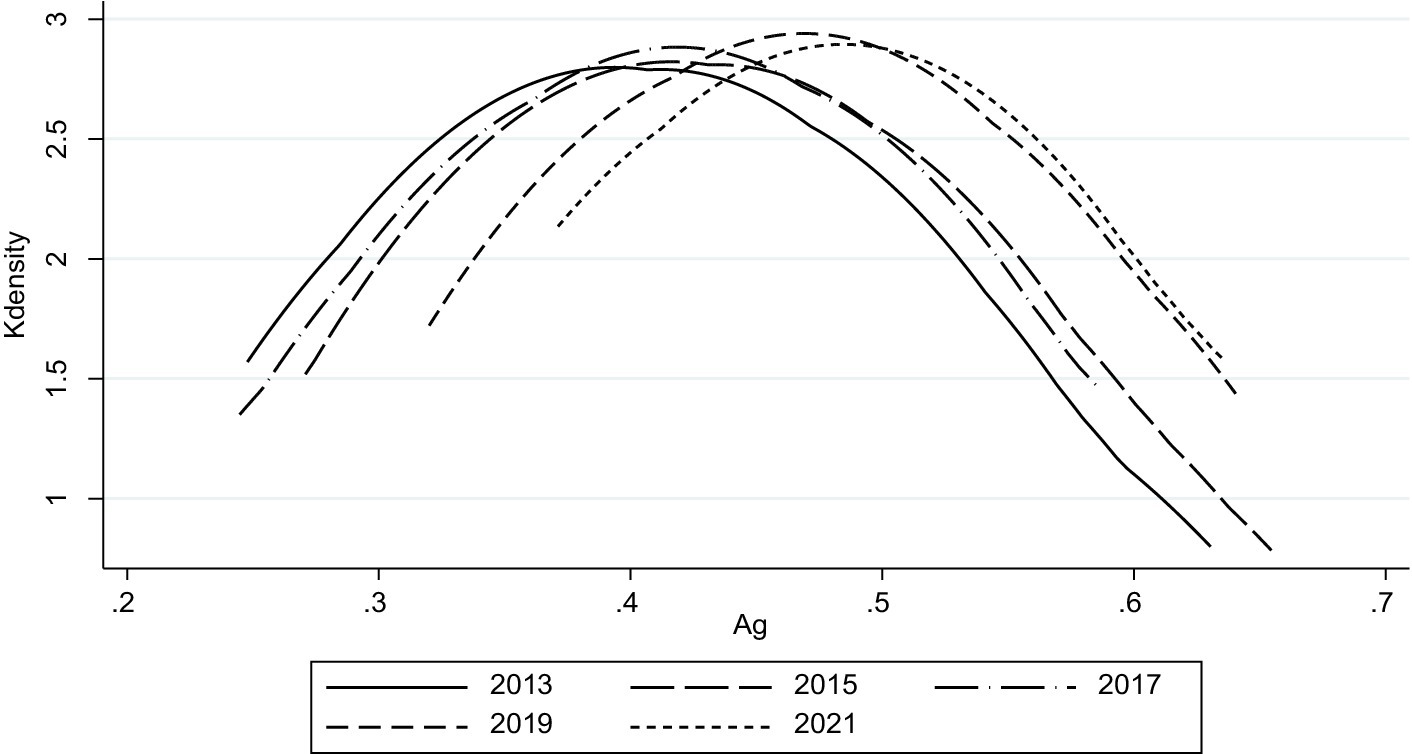
Figure 2. Kernel density profiles for 13 cities in Jiangsu Province in odd-numbered years during 2013–2021.
5.2 Benchmark regression
According to the previous model design, this paper used a fixed effects model to regress the total sample (Table 4). In exploring the impact of digital economy on the development of high quality in agriculture, the preliminary analyses of this study show that digital economy has a significant positive effect on the improvement of quality and efficiency in agriculture. Before the introduction of control variables, the coefficient of digital economy is 0.202, which is significant at 1%. After further adding each control variable one by one, the coefficient of the digital economy is still significantly positive at a high level of significance, and when all of them are included in a number of control variables, although the coefficient decreases slightly, the positive effect is still confirmed at a significance level of 5 per cent, which is a finding that fully supports the research hypothesis 1.
5.3 Convergence test
The convergence model is an important method for analyzing regional disparities, based on the convergence theory in neoclassical economic growth theory (Wang et al., 2006). The results of the β-convergence test for the level of high-quality agricultural development are shown in Table 5.
Table 5 Model 1 show that the coefficient of the lagging period of high-quality agricultural development is significantly negative, indicating the existence of absolute β-convergence characteristics. The past decade has been the golden decade for high-quality development in Jiangsu Province, and the quality and efficiency of economic development in all regions have steadily improved. The disadvantages of information, transportation, and markets in the lagging areas of high-quality development in agriculture are gradually improving, which makes the development speed of the lagging areas exceed that of the developed areas, and the gap in the high-quality development level of agriculture among the regions is gradually narrowing. The overall situation shows that it is moving towards the balanced development of the region, and hypothesis 2 has been verified. Table 5 Model 2 is the conditional convergence results after adding a series of control variables, the results show that there is conditional convergence of high-quality agricultural development; Table 5 Models 3, 4 are the regression results of adding the digital economy (lnDeli,t) and its interaction term with the lagged first-order term of high-quality agricultural development (lnDeli,t*lnAgi,t-1), and it can be seen from the regression results that the digital economy (lnDeli,t) and its high-quality agricultural development lag term interaction term (lnDeli,t*lnAgi,t-1) coefficients are significantly negative, meaning that the digital economy makes the high level of high-quality agricultural development of the region than the low level of the region with a lower rate of growth, indicating that the digital economy in high-quality agricultural development of the convergence effect of digital economy plays a positive role in the convergence effect of the high-quality agricultural development of the digital economy in the agriculturally developed regions empowerment is weak, and empowerment is strong for backward areas.
The reason behind this could be that Jiangsu Province has consistently and thoroughly implemented an innovation-driven development strategy as well as a rural revitalization strategy. It has also directed a variety of scientific and technological resources to concentrate in central and northern Jiangsu Province to promote the efficiency and quality of agriculture in these regions, providing both financial and scientific support for the modernization of rural areas and agriculture in backward regions. The comparatively underdeveloped Central and Northern Jiangsu areas have had a faster rate of increase in agricultural quality development than the developed Southern Jiangsu region, thanks to policy assistance, which has helped close the gap in regional differences in high-quality agricultural development.
5.4 Non-linear model estimation
Table 6 reports the results of the estimation of the threshold model for the digital economy on agricultural quality development. The regression results of the threshold model 1 with agricultural quality development (Ag) as the threshold variable show that the coefficient value of digital economy is 0.226 and significant at the 5% level in areas with Ag value less than 0.371, while the coefficients of digital economy are 0.086 and − 0.123, respectively, which are not significant in areas with Ag values between 0.371 and 0.451, and in areas with Ag value greater than 0.451. According to the results of Threshold Model 1, digital economy and agricultural high-quality development have a significant positive relationship in regions with a low level of agricultural high-quality development, while the promotion or inhibition between the two is not significant in regions with either a medium or a high level of agricultural high-quality development, which verifies hypotheses 2 and 3. The regression results of Threshold Model 2 with regional per capita gross domestic product (Pgdp) as the threshold variable, the impact of digital economy’s impact on high-quality agricultural development shows regional variability. In regions with Pgdp greater than 56105.905, the effect is relatively weak, with a coefficient of only 0.154 at the 5% significance level, while in regions with Pgdp less than 56105.905, the effect is significantly stronger, with the coefficient rising to 0.412 and being significant at the 1% level. The facilitating effect of the digital economy is more prominent in economically backward regions, revealing the heterogeneous performance of the potential of the digital economy under different economic conditions (Li and He, 2023).
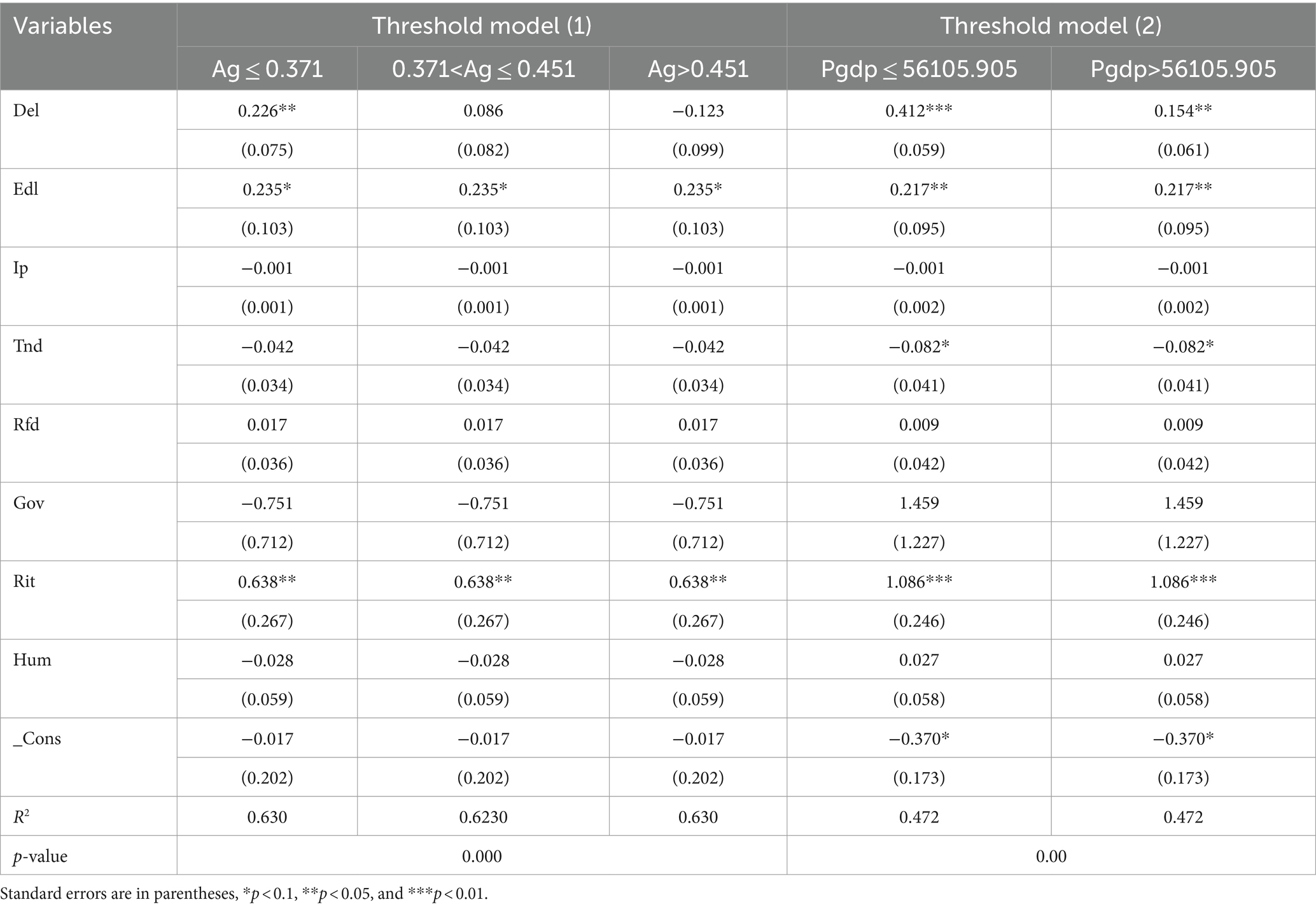
Table 6. Analysis of the results of the estimation of the model of the threshold of the digital economy for the high-quality agricultural development.
5.5 Robustness check
The expenditure on science and technology could not cover only ‘digital’ stuff. Therefore, as shown in Table 7, science expenditures were deleted from the original evaluation system, another indicator (Del’) was created that excludes this expenditure, and this indicator (Del’) was used as a robustness check in the analysis.As can be seen from Table 8, this indicator of the digital economy(Del’) remains highly significant at the 5% level, and the positive effect on high-quality agricultural development is also still obvious; thus, the model is robust.
The convergence test used in this paper is consistent with the panel threshold model estimation results, and the results of the test in both cases are consistent and highly significant, passing the robustness test. Considering that the effect of digital economic empowerment has a time lag, to further test the robustness of the baseline regression results, this paper uses the lagged first-order term of the digital economy (L.Del) as a new explanatory variable and regresses the model again. As can be seen from Table 8, the lagged first-order term of the digital economy (L.Del) remains highly significant at the 1% level, and the positive effect on high-quality agricultural development is still obvious.
5.6 Expanded analysis: spatial effects
Theoretically, the network externalities of the digital economy facilitate the free flow of agricultural resources between different sectors and geographical areas (Zhang and Wang, 2022). This in turn creates a spillover effect of technological innovation and encourages the coordinated development of agricultural quality across different sectors and geographical areas. This paper investigates the regional spillover impact between agricultural quality development and the digital economy. In order to calculate the spatial autocorrelation between the digital economy and high-quality agricultural development in each year under the economic distance weight matrix, this paper uses the whole-area Moran’s I method prior to performing a spatial econometric analysis. The results are displayed in Table 9, where the Moran indices of two variables are significantly positive at the 1% level. This suggests a significant positive spatial correlation between the digital economy and high-quality agricultural development in Jiangsu Province from 2013 to 2021.
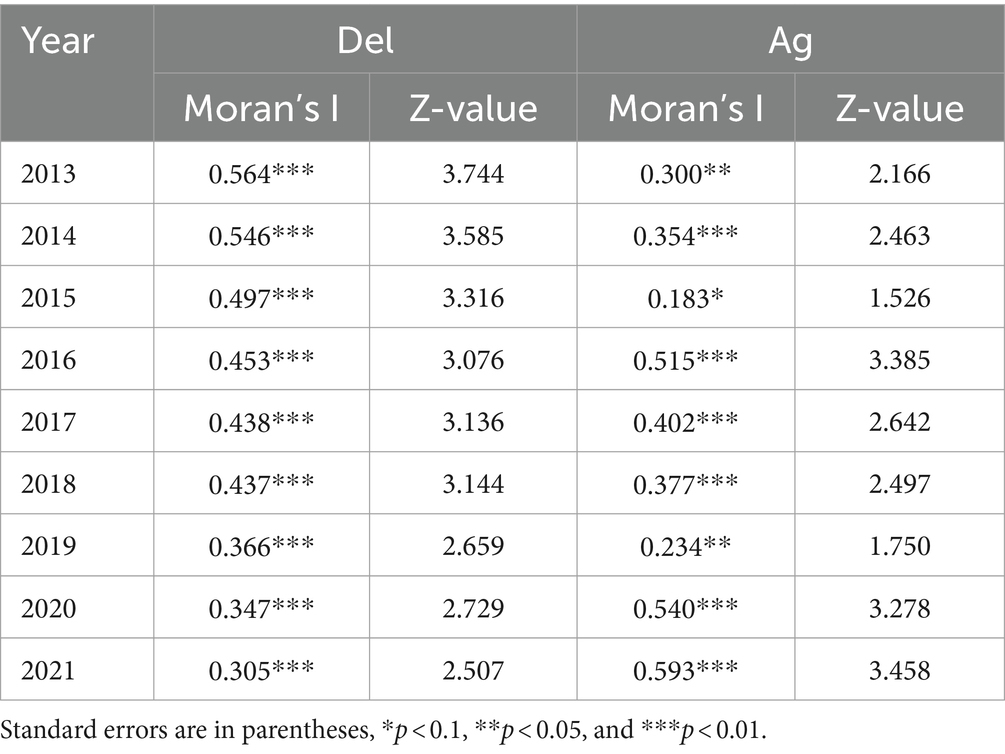
Table 9. Global Moran’s I of digital economy and high-quality agricultural development in Jiangsu Province, 2013–2021.
Further, the majority of the cities are distributed in the HH and LL quadrants, which suggests that there is a phenomenon of spatial clustering of the level of high-quality development of the digital economy and agriculture in the cities in Jiangsu, and initially verifies the spillover effect of the two (Duan and Xuan, 2021). A Moran scatter plot was used to examine the geographic distribution of the high-quality development of the digital economy and agriculture in 2021 (Figure 3).
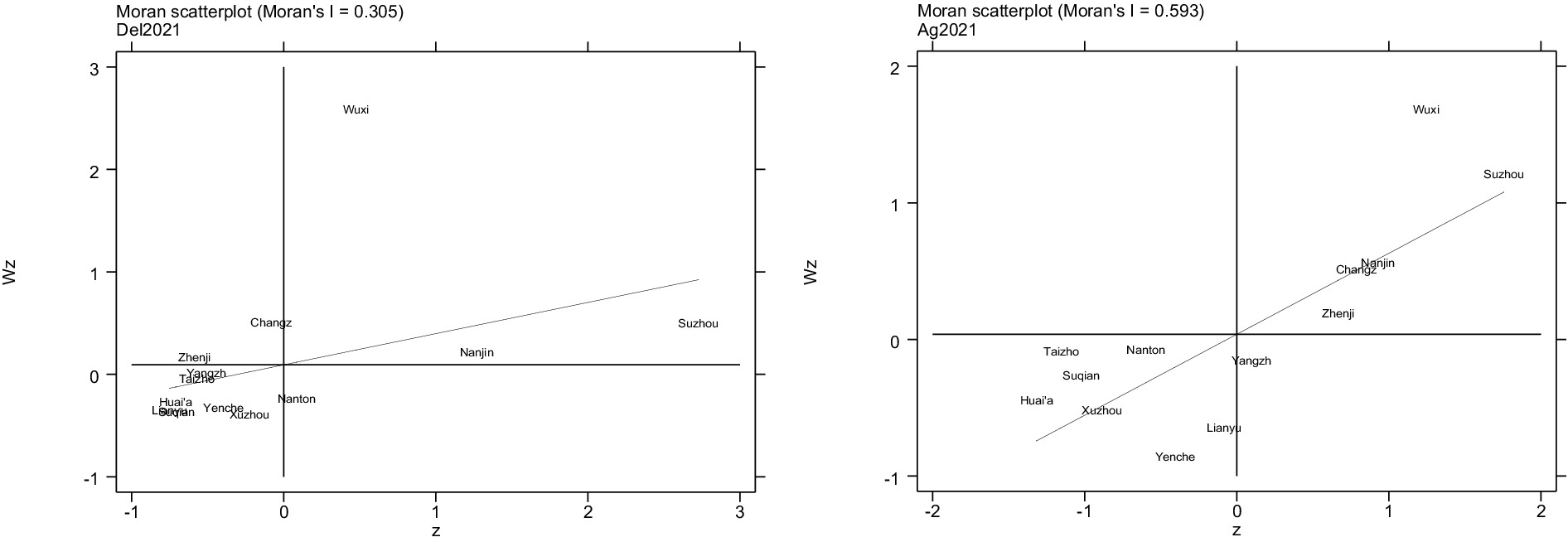
Figure 3. Local Moran’s I scatter plot of digital economy and high-quality agricultural development in Jiangsu Province in 2021.
The choice of whether to use the spatial lag model or the spatial error model was further made by comparing the statistical values of LM (lag), Robust-LM, LM (error), Robust-LM (error), and significance among the LM test results. The test results are shown in Table 10, where the test statistics of LM (error), Robust-LM (error), and Robust-LM (lag) are highly significant at the 1% level, but the test statistics of LM (lag) are not significant. Therefore, this paper chooses the spatial error model for the next empirical analysis.
Table 11 presents the regression outcomes of the spatial error panel model using the spatial weight matrix of economic distance. The results show that the digital economy (Del) in the city fixed-effects model is highly significant at the 1% significance level, indicating that there is a significant positive spatial correlation between the digital economy and high-quality agricultural development. That is, the development of the digital economy in cities with similar levels of economic development will have an impact on the level of high-quality agricultural development in Jiangsu Province, demonstrating that the digital economy has a spatial spillover effect on high-quality agricultural development, thereby validating hypothesis 4.
The reason behind this may be that the strong penetration, high innovation and wide coverage of the digital economy can weaken the correlation between economic activities and geographic location, enhance cross-regional economic collaboration and division of labour, and show spatial spillover effects. Therefore, the degree of development of the digital economy in one region may affect the level of high-quality agricultural development in another region. On the one hand, developed regions can play the technology spillover effect and demonstration effect of digital economy (Yin and Wei, 2024), transfer mature agricultural digital technology and advanced management experience to the neighbouring regions that are relatively backward in terms of development, and these advanced technologies and concepts are easy to take the lead in spreading and promoting in the regions of similar level of economic development, so as to alleviate the unequal development of regional agriculture. On the other hand, through the network effect of the digital economy to reshape the urban spatial pattern (Zhao and Wan, 2023), agricultural products can be more conveniently sold to a wider market by using online retailing and e-commerce platforms, which gives more development opportunities to small towns. Driven by the digital economy, small towns with a similar level of economic development can more effectively tap into and make use of the local agricultural characteristics by simulating innovative market and channel expansion strategies, and promote their agriculture to the level of large cities and promote their agriculture to be closer to the level of big cities.
6 Conclusions and recommendations
China’s agriculture is currently in a period of transformation of development mode, optimization of economic structure, and transformation of growth momentum. In the era of digital economy, Jiangsu Province has taken the lead in transforming development momentum and utilizing digital elements to promote agricultural modernization. This is a practical requirement for Jiangsu Province’s agricultural development to enter a high-quality new stage, an important lever for achieving rural revitalization, and a major strategy for promoting the transformation from a large agricultural province to a strong agricultural province.
Through fixed effects, convergence test, threshold model, and spatial error model, the above research shows that (1) the digital economy can significantly promote the high-quality development of agriculture. This conclusion still holds true in multiple robustness tests, which has strong policy implications for Jiangsu Province to build a strong agricultural province and can support China’s construction of an agricultural powerhouse. (2) High-quality agricultural development has obvious regional convergence; the growth rate of high-quality agricultural development in backward areas is higher than that in developed areas, and the level of high-quality agricultural development in various places tends to be consistent. The digital economy contributes positively to the regional convergence of high-quality agricultural development and strongly encourages the level of high-quality agricultural development in backward areas, while playing a less significant role in developed areas. The digital economy has brought opportunities for agricultural development in underdeveloped areas. (3) The digital economy has a spatial spillover impact on high-quality agricultural development, which can raise the standards of high-quality agricultural development in nearby areas with comparable economic levels. Regions with similar economies, due to similar digital infrastructure conditions, have the ability to undertake digital dividends and accelerate the modernization of agriculture and rural areas.
Therefore, the following policy recommendations are made in this paper: (1) Jiangsu Province should seize the opportunities of digital economy development, accelerate the technological transformation of agricultural production, expand the multifunctionality of agriculture, promote the application of agricultural Internet of Things, develop agricultural information service industry, and support the rise of rural e-commerce. Expand the application of digital technology, continuously improve agricultural production efficiency and quality, and continuously increase the income of farmers. Actively promote the combination of traditional agriculture and the Internet, break the problem of information asymmetry, make agricultural products more convenient to market, and inject new vitality into rural economic development. The modernization of agriculture in Jiangsu Province still has a long way to go. Governments and enterprises at all levels need to increase their investment to jointly promote the deep integration of digital economy and agriculture, and help the vigorous development of agriculture in the province.
(2) With the rapid development and popularization of the digital economy, there is still a significant gap in digital transformation in underdeveloped areas, and more support and assistance are needed to accelerate the pace of development. Jiangsu Province will continue to strengthen the construction of digital economy development in underdeveloped areas, provide more policy funding support and digital technology assistance for remote areas, and accelerate the narrowing of the gap in agricultural development between regions. The Jiangsu Provincial Government should formulate more precise policy measures, establish special funds for the development of the digital economy, and increase technical assistance to remote areas, providing training and technical support, to ensure that digital technology can effectively help improve the regional economy. By strengthening support and assistance to underdeveloped areas, it will help narrow the gap in agricultural development between regions and achieve the goal of coordinated economic and social development throughout the province.
(3) Various regions in Jiangsu Province should attach great importance to the exchange and cooperation of digital agriculture construction, especially in areas with similar economic levels. We need to promote the sharing of digital technology and management experience among regions through various means such as establishing a sound information exchange mechanism, building online learning platforms, strengthening digital talent cultivation and cooperation. By strengthening cooperation and jointly promoting the construction of digital agriculture, we will inject new impetus into the upgrading of the agricultural industry. By sharing resources, experience, and technology, a mutually beneficial and win-win situation can be achieved, promoting the optimization and upgrading of the entire agricultural industry chain, and achieving the goal of sustainable economic and social development.
Data availability statement
The original contributions presented in the study are included in the article/Supplementary material, further inquiries can be directed to the corresponding author.
Author contributions
XM: Conceptualization, Data curation, Funding acquisition, Investigation, Methodology, Project administration, Resources, Supervision, Visualization, Writing – review & editing. LL: Data curation, Formal analysis, Investigation, Resources, Software, Supervision, Validation, Visualization, Writing – original draft.
Funding
The author(s) declare financial support was received for the research, authorship, and/or publication of this article. This research was funded by the National Social Science Foundation of China, grant number 22AGL024; the Graduate Innovation Program at Yangzhou University School of Business, grant number SXYYJSKC202337.
Conflict of interest
The authors declare that the research was conducted in the absence of any commercial or financial relationships that could be construed as a potential conflict of interest.
Publisher’s note
All claims expressed in this article are solely those of the authors and do not necessarily represent those of their affiliated organizations, or those of the publisher, the editors and the reviewers. Any product that may be evaluated in this article, or claim that may be made by its manufacturer, is not guaranteed or endorsed by the publisher.
Supplementary material
The Supplementary material for this article can be found online at: https://www.frontiersin.org/articles/10.3389/fsufs.2024.1424097/full#supplementary-material
References
Acharya, R. C., and Keller, W. (2008). Estimating the productivity selection and technology spillover effects of imports. Cepr Discussion Papers. doi: 10.3386/W14079
Arrow, K. J. (1971). The economic implications of learning by doing. In Readings in the theory of growth. London: Palgrave Macmillan, 131–149.
Barro, R. J., and Sala-i-Martin, X. (1997). Technological diffusion, convergence, and growth [J]. J. Econ. Growth 2, 1–26. doi: 10.1023/A:1009746629269
Bloom, N., Draca, M., and Van, R. J. (2016). Trade induced technical change? The impact of Chinese imports on innovation, IT and productivity. Rev. Econ. Stud. 83, 87–117. doi: 10.1093/restud/rdv039
Brynjolfsson, E., Hu, Y. J., and Smith, M. D. (2006). From niches to riches: anatomy of the long tail. MIT Sloan Manag. Rev. 4, 67–71. Available at: https://webofscience.clarivate.cn/wos/alldb/full-record/WOS:000239175900013
Cardona, M., Kretschmer, T., and Srtobel, T. (2013). ICT and productivity: conclusions from the empirical literature. Inf. Econ. Policy 3, 109–125. doi: 10.1016/j.infoecopol.2012.12.002
Chernova, O. A., Mitrofanova, I. V., Adamičková, I., and Kleitman, E. V. (2022). Digitalization of agricultural industry—the vector of strategic development of agro-industrial regions in Russia. AGRIS Online Pap. Econ. Inform. 14, 45–58. doi: 10.7160/aol.2022.140104
Duan, J.., and Xuan, Z. (2021). Analysis of the coupling relationship between county economic resilience and rural revitalization in Jiangsu Province under the background of Yangtze River Delta integration. J. Suzhou Univ. (Philos. Soc. Sci. Ed.) 3, 32–43. doi: 10.19563/j.cnki.sdzs.2021.03.004
Fang, X., Wei, J., and Guo, L. (2017). Reflection and reconstruction of sustainable development theory. Economist 3, 24–31. doi: 10.16158/j.cnki.51-1312/f.2017.03.005
Freeman, C. (1987). Technology policy and economic performance: Lessons from Japan. London: Pinter Publisher.
Fritsch, U., and Görg, H. (2015). Outsourcing, importing and innovation: evidence from firm level data for emerging economies. Rev. Int. Econ. 4, 687–714. doi: 10.1111/roie.12187
Fu, H., and Li, X. (2023). Mechanisms and effects of digital economy-driven agricultural modernization in China. J. South China Agric. Univ. (Soc. Sci. Ed.) 3, 18–31. Available at: https://kns.cnki.net/kcms2/article/abstract?v=G7eKQ1uxNXcTlR6jQXeT-korPAvVe7FkW8Xtt2ns4SiQPQgLFe6HEazz_VJgDy1zvVTsVpBz91W-gBlcUa5AcJDPmEezBw-7Gjhka5duQ-ZZxF5FxOOUVsL7q5HvSKLSRm0A8hCCWmiRvJKknvy9njj0uCQbH_b9palFGQzSwIr9MsXnq2Sb-cKxosgNJovx7-_vZtXOYQdYxKK-nEOVQX4YtDNEr8VzJLS84OVzSCNcSE_geouJUsrcBfmR6_4k_3i6UuIo1zvkF6RSnHY7SHNqFrSsfkvfeEtXtHZkzRB4JADkKnz5CJ1UyAOCqIgD&uniplatform=NZKPT&language=CHS
Gao, Y., Wang, L., Li, Z., Liu, H., and Liu, Y. (2017). “Internet+agriculture”: reconstructing the development mode of the whole industrial chain of agricultural products. World Agric. 12, 11–17. doi: 10.13856/j.cn11-1097/s.2017.12.0
Ge, H., Li, B., Tang, D., Xu, H., and Boamah, V. (2022). Research on digital inclusive finance promoting the integration of rural three-industry [J/OL]. Int. J. Environ. Res. Public Health 6. Available at: https://www.mdpi.com/1660-4601/19/6/3363
Goldberg, P. K., Khandelwal, A. K., Pavcnik, N., and Topalova, P. (2010). Imported intermediate inputs and domestic product growth: evidence from India. Q. J. Econ. 125, 1727–1767. doi: 10.1162/qjec.2010.125.4.1727
Guo, H., Gu, F., Peng, Y., Deng, X., and Guo, L. (2022). Does digital inclusive finance effectively promote agricultural green development?—a case study of China. Int. J. Environ. Res. Public Health 12. Available at: https://www.mdpi.com/1660-4601/19/12/6982
Hu, H., and Xing, H. (2003). The theory of industrial integration and its implications for the development of information industry in China. China Ind. Econ. 2, 23–29. doi: 10.19581/j.cnki.ciejournal.2003.02.003
Li, M., and He, J. (2023). Research on digital economy empowering high-quality development of agriculture--an analysis based on panel data of Hunan Province from 2012 to 2020. J. Hunan Agric. Univ. (Soc. Sci. Ed.) 1, 14–23. doi: 10.13331/j.cnki.jhau(ss).2023.01.003
Li, Y., and Ruan, L. (2023a). The expansion path and policy orientation of Chinese-style agricultural and rural modernization in the context of digital economy. J. Xi'an Univ. Financ. Econ. 2, 21–29. doi: 10.19331/j.cnki.jxufe.20230214.005
Li, Y., and Ruan, L. (2023b). Digital economy empowers Chinese-style agricultural and rural modernization: theoretical logic and empirical evidence. Econ. Issues 8, 25–32. doi: 10.16011/j.cnki.jjwt.2023.08.015
Li, B., and Yue, H. (2022). Digital economy empowers high-quality development of agriculture: theoretical logic and empirical test. J. Jiangxi Univ. Finance. Econ. 6, 95–107. doi: 10.13676/j.cnki.cn36-1224/f.2022.06.004
Lu, Z., and Du, Y. (2022). An empirical study of digital economy empowering high-quality development of agriculture. China Circ. Econ. 11, 3–14. doi: 10.14089/j.cnki.cn11-3664/f.2022.11.001
Luo, Q. F., Zhao, Q. F., and Zhang, L. Z. (2022). Theoretical framework, efficiency enhancement mechanism and realisation path of digital technology enabling highquality agricultural development. Contemp. Econ. Manage. 7, 49–56. Available at: https://kns.cnki.net/kcms2/article/abstract?v=G7eKQ1uxNXcOtqc1OzQ061NFTkDq9QU00ehCK72TZJBN7pIO0bNdS-6NAkUNxpbAdki37mBoPRieP3H8S4SyodF9GIHWAGX15xl_TvT8u4UqhGMu5PWybN40YuqLBdqMb6J7CNaNSi3mpX32BYdItz4CDT77Wf9qApFM4SAUHCn7Hwq9ULgZnEakSCIsQzcuzfdaDSOsw66bJQHAzNZrGXldzDrKRlA4dG-zxq1S1KZ-skaE8vUEqCccmxR8F7cJZPmlt2-0_tM6IkojQNXEOQD-l5oOUk2JT5aDF8RdEiOmUnGvRGQk8WGBvqkNSweY&uniplatform=NZKPT&language=CHS
Schmookler, J. (1962). Economic sources of inventive activity. J. Econ. Hist. 22, 1–20. doi: 10.1017/S0022050700102311
Schumpeter, J. A., Schumpeter, J., Schumpeter, J., Schumpeter, J. P., Schumpeter, J. A., Schumpeter, J., et al. The theory of economics development. J. Pol. Econ. (1934) 1, 170–172.
Stirling, D. A. (2003) Information rules. International conference on management of data, vol. 2, 59.
Su, Y. Q., You, Y. T., and Wang, Z. G. (2016). Integrated development of rural one, two and three industries: theoretical discussion, current situation analysis and countermeasure suggestions. China Soft Sci. 8, 17–28. Available at: https://kns.cnki.net/kcms2/article/abstract?v=G7eKQ1uxNXdalDYdvJg7mrENfeD0UXUTtyv4IJ6YDpsy0SdsjzjOT56GJOs1m5ueYV3RKB4NpZXEnA937ejBGZ0vqBYdZbpBhL-N8RP5TEQesmG0JCMywC7Vo1-lvAnIvz1vepfTYuhkyEUL6kiU7LwyIqikA297ey_XnZd1-qtUNSyNIT-q31fGuMGIwqXDHAfCl7o8wGAklnuDEhePJcu-XpD8nJibwmweJnaspleTNRULgMJy_fE3MWy40mlYck48JoYczSG9dPlZYkEAX0I0GA3SYsB4BM8F9dYZdc76TVGk47idIEbWtWGYQYgM&uniplatform=NZKPT&language=CHS
Wang, Y. (2023). Digital divide and state protection of digitally disadvantaged groups. Comp. Law Res. 5, 121–137. Available at: https://kns.cnki.net/kcms2/article/abstract?v=G7eKQ1uxNXcvx6y-20BeRejr1N-CtmH-ISbZtq-3r_JcxV6hU_vL4kLmllczQ0vTS3VsLtVSOjnyr7oON7oIb69xABdrS9W8jE2oIAV2cL5fPmNYljPwOVZSgQ9tGhEwcLaElUYi4qydsEp35Zcpebg2LbidK_d047qjkMS9z0DAuUWjefg0Zt-VHVpeQvdoNHalWiZOP6k5UtZzJXEDrUzqgm6kkFEqIIAZ6VgRUx-9kx8en2W8Cvun5PWnpN5c36d6Qsq2SP9oDKMYq5YqR9M8A0DLOTsEaV9P8n1FpTMLgqGTg8agAU4FnhUIM9kq&uniplatform=NZKPT&language=CHS
Wang, J., Shi, M., and Li, Z. (2023). Digital economy drives high-quality development of agriculture: internal mechanism and empirical evidence. J. Xi'an Univ. Financ. Econ. 4, 78–89. doi: 10.19331/j.cnki.jxufe.20230724.002
Wang, F., Zhang, Z., and Kang, J. (2006). Enterprise marketisation, opening up and the convergence of growth conditions in China. World Econ. 6, 48–60. Available at: https://kns.cnki.net/kcms2/article/abstract?v=G7eKQ1uxNXcS8avSCQY5Wyfb6zMffMZDTBbOS-2zFfhea9D64T0ddeztisj_Ih-nC8I7gGySXzcUs39CHwUtzqWilxpmi-6mBTgkMEwTmdqKZEoR0PtqRlEfYgUY1wVSv5pfVP0SAzc9q22QxRfDr9T132OBbNSClshSuNDNjM_sL3X-4kTbCWOTX8Y47euV-Qkj2dIBoOB9EY1dyxg8gTJOZ0SYgbpP6jLVrw31einVBup7Gu5e19q7243uELRh5mgEfeqB2YcY5FTQvGb1B8jjc8xQRKKFa2Ks1GKK8shOiI-QuyF4-SNP-VPuPh6Y&uniplatform=NZKPT&language=CHS
Wei, X., and Wang, M. (2018). The whole industry chain model boosts agricultural industry upgrading under the background of internet+. Shandong Soc. Sci. 10, 167–172. doi: 10.14112/j.cnki.37-1053/c.2018.10.026
Xi, J. (2022a). Holding high the great banner of socialism with Chinese characteristics and uniting to strive for the comprehensive construction of a socialist modernized country. People's Daily 1:8. doi: 10.28655/n.cnki.nrmrb.2022.011568
Xi, J. P. (2022b). Continuously strengthening and optimizing China's digital economy. Pioneer 3, 5–7. Available at: https://kns.cnki.net/kcms2/article/abstract?v=G7eKQ1uxNXchFip0uWnwzCTIXaXZyRTPvtyIHA0EFluRMdEvE7s7reBULU4Rg6x9GfUbhaGLThJcOxhZATXV2VOzTbuqzoFe1VOKBP1NydmbWAnXDCftTf4AAs9Dbwz1cBUHi9SQrZGJOyeB0_LpbM-4w95CkbyR6lBDVnIxrGCQKHJFV-PWSSKnMX0nDzxfoVUq3paJXDgmrJdRJdFj664P9lpmOEhu6_QsLIV6PJ4v87BvqJvyyv9ADxEkbZZuoRKEOU8Vc6KXf-NDCkJls2zSjtyUrXFSDtuZSUbQja6i1mInroIKgarquIaXhSAP&uniplatform=NZKPT&language=CHS
Xia, X. L., Chen, Z., Zhang, H., and Zhao, M. (2019). High-quality development of agriculture: digital empowerment and realization path. China Rural Econ. 12, 2–15. Available at: https://kns.cnki.net/kcms2/article/abstract?v=G7eKQ1uxNXdTa5hxYtUWj6swH58U8UH1dKtVDLANhy2yux6nzyXrWIAD58Ro-a7-bQmY3gGA3NBL2uemwwxLpwT0AlAb51QdHR6oaGfXjq0t3kI626Ly6dr4z_jVL42yngSPzlua6lc5pZgAiw4koFic77nevLBUFbykO1rrkfv9IKfDAzbzNjTT8-pCkwDkl9IV1g2kr3YjbJV9FMU2wW7ns1IC2vkuz8pIo3gVakfmHZWMc6-vkLVj35zroN6dIhcpaYRbTdw=&uniplatform=NZKPT&language=CHS
Yi, E., Wang, J., and Zhu, J. (2023). Digital economy, resource allocation efficiency and high quality development of agriculture. J. Tianjin Univ. Financ. Econ. 12, 20–37. doi: 10.19559/j.cnki.12-1387.2023.12.002
Yin, X., and Wei, M. (2024). Digital economy development and regional economic convergence – an empirical study based on dynamic spatial panel model. Econ. Manage. Rev. 2, 29–42. doi: 10.13962/j.cnki.37-1486/f.2024.02.003
Zhang, S., and Chen, Z. (2021). Mechanism identification and heterogeneity study of digital economy and regional economic growth. Stat. Inf. Forum 11, 14–27.
Zhang, H., and Li, J. (2020). Agricultural technological progress, rural labor force transfer and urban-rural income gap--a subgroup study based on agricultural labor productivity. East China Econ. Manage. 1, 67–75. doi: 10.19629/j.cnki.34-1014/f.190621012
Zhang, J., and Wang, H. (2022). Coordinated development of digital economy, industrial structure, and bidirectional FDI: an empirical study based on the Yangtze River Delta region. J. Harbin Bus. Univ. (Social Sciences Edition). 6, 78–91. Available at: https://kns.cnki.net/kcms2/article/abstract?v=G7eKQ1uxNXfcXW8E-I6wb_N0DrbQ9lahgEsCyBKavcjC0ArOwk4XB0zJfAwTC_jJ7-xjaM7a9SO5NYn-v4ywfCeKnQcScmUIeItjqGiiBAjiyYvBDjnSQnnBbFE-9RyXy3aaCaj0s3wJfof4UmjtUUfBsi_ZfjmTHX28zJi5C8ljQ4o6TzaoYjisorH_OsKEYq_t0ASoWYVMXPxB4_1YX6XpEWsNKkNEripU2LbY594KNyO6m9NQEkvzibOa47gL4RvQGUOTy3tY-jJlJEet58uOftDTO_0r8u13NTvoJ7aT56egvqookve5ZcBk1QAh&uniplatform=NZKPT&language=CHS
Zhao, X., and Wan, M. (2023). Digital economy, new urbanization and spatial spillover effects. Shandong Soc. Sci. 11, 145–153. doi: 10.14112/j.cnki.37-1053/c.2023.11.023
Zhao, T., Zhang, Z., and Liang, S. (2020). Digital economy, entrepreneurial activity and high-quality development-empirical evidence from Chinese cities. Manage. World 10, 65–76. doi: 10.19744/j.cnki.11-1235/f.2020.0154
Zheng, G., and Wan, M. (2023). The productivity growth effect of digital economy: dividend or divide. Contemp. Financ. Econ. 12, 3–16. doi: 10.13676/j.cnki.cn36-1030/f.20230906.004
Zhou, Q. X., and Li, X. E. (2022). Digital economy and high-quality development of agriculture: internal mechanism and empirical analysis. Econ. Syst. Reform. 6, 82–89. Available at: https://kns.cnki.net/kcms2/article/abstract?v=G7eKQ1uxNXcGixn16I1jR5wI99AGYwvMJgCJDWs1dVx47bq4Ly5L2j-hQ25-ec2vBD8FwyvtgIRMO1D1E-K0gQRBENmCt--nLBiRpTeFjBLa-fBZzVWTEGNS_AnZSeo8oA4-cRDlCMAkF2DA0B7S2gokk94ioe3t1f2cAHlrryC5yl2CKJs3WifrNssERP9ijsexDBcEDBD7-eLkx8RnlBr35ws96W9Trmf0r3l2JEC-J2xA-NaC93lT2c9a31eQgsLHJiggYtg=&uniplatform=NZKPT&language=CHS
Keywords: digital economy, high-quality agricultural development, digital dividend, convergence test, threshold model, spatial error model
Citation: Ma X and Lv L (2024) Facilitating the high-quality agricultural development with digital economy: a panel data study of Jiangsu Province from 2013 to 2021. Front. Sustain. Food Syst. 8:1424097. doi: 10.3389/fsufs.2024.1424097
Edited by:
Sourangsu Chowdhury, Centre for International Climate and Environmental Research (CICERO), NorwayReviewed by:
Esther Folarin, Covenant University, NigeriaSeyed-Hassan Miraei Ashtiani, Dalhousie University, Canada
Copyright © 2024 Ma and Lv. This is an open-access article distributed under the terms of the Creative Commons Attribution License (CC BY). The use, distribution or reproduction in other forums is permitted, provided the original author(s) and the copyright owner(s) are credited and that the original publication in this journal is cited, in accordance with accepted academic practice. No use, distribution or reproduction is permitted which does not comply with these terms.
*Correspondence: Lianzhou Lv, MTQ0NjM2NjQ4NEBxcS5jb20=
 Xiaoxu Ma
Xiaoxu Ma Lianzhou Lv
Lianzhou Lv